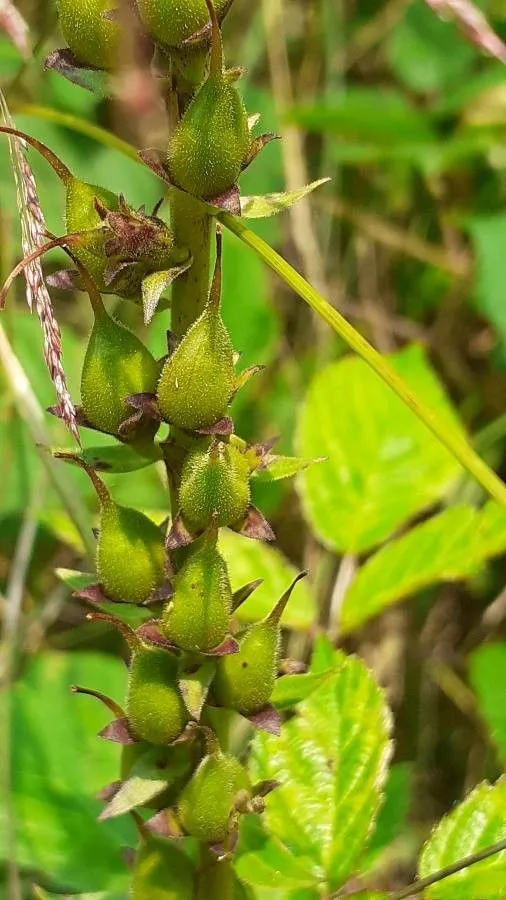
Author: L.
Bibliography: Sp. Pl.: 368 (1753)
Year: 1753
Status: accepted
Rank: species
Genus: Digitalis
Vegetable: Unknown
Observations: C. Europe
Straw foxglove, known scientifically as Digitalis lutea, is a captivating perennial plant that belongs to the Plantaginaceae family. Native to Central Europe, this plant has been recognized and documented since 1753 under the authorship of the renowned botanist Carl Linnaeus, often abbreviated as “L.”
This species is distinguished by its elegant, tubular yellow flowers, which bloom in dense spikes. The delicate blossoms of Digitalis lutea typically appear in early summer, adorning gardens and natural landscapes with their subtle beauty. The plant features narrow, lance-shaped leaves arranged in a basal rosette and along its slender stems, which can reach heights of up to one meter.
Straw foxglove thrives in well-drained soils and partial shade, making it a versatile addition to various garden settings. Its preference for temperate climates aligns perfectly with its origins in Central Europe, where it flourishes in meadows, woodland edges, and hillsides.
Gardeners cherish Digitalis lutea not just for its ornamental appeal but also for its resilience and low maintenance needs. It provides a graceful touch to perennial borders, cottage gardens, and wildflower meadows. While not as widely known as some of its more flamboyant relatives, such as the common foxglove (Digitalis purpurea), straw foxglove offers a more understated charm that is appreciated by those who favor subtlety and elegance in their garden compositions.
In addition to its horticultural value, Digitalis lutea is noted for its historical use as a source of digitalis compounds, which have been used medicinally to treat heart conditions. However, it is important to handle all parts of the plant with care, as they contain potent chemicals that can be toxic if ingested.
In summary, the straw foxglove is a noteworthy plant that blends beauty with practicality, allowing gardeners to enjoy its gentle blooms and easygoing nature. As a native of Central Europe, it continues to enchant plant enthusiasts and horticulturists alike, holding a special place in both wild and cultivated spaces.
Deu: gelber fingerhut
Dan: gul fingerbøl
Eng: straw foxglove, small yellow foxglove
Nob: gul revebjelle, gulrevebjelle
Nno: gul revebjølle, gulrevebjølle
Swe: liten fingerborgsblomma
Ces: náprstník žlutý
Hun: vajsárga gyűszűvirág
Nld: geel vingerhoedskruid
Fra: digitale jaune, digitale à petites fleurs, petite digitale
Cym: bysedd-y-cŵn melyn
En: Straw foxglove, Small Yellow Foxglove, Yellow foxglove
Sq: Luletogëza e verdhë
Ar: قمعية صفراء
Ca: Didalera groga, Digital groga
Zh: 黃花毛地黃
Cs: Náprstník žlutý
Da: Gul Fingerbøl
Nl: Geel vingerhoedskruid, Stro-Vingerhoedskruid
Et: Kollane sõrmkübar
Fi: Pikkusormustinkukka
Fr: Digitale jaune, Digitale à petites fleurs, Petite Digitale
De: Kleiner Gelber Fingerhut, Gelber Fingerhut, Kleinblütiger Fingerhut
Hu: Vajsárga gyűszűvirág
It: Digitale gialla piccola
Nb: Gul revebjelle, Gulrevebjelle
Nn: Gul revebjølle, Gulrevebjølle
Pl: Naparstnica żółta
Sk: Náprstník žltý
Es: Dedalera de San Jerónimo, Digital amarilla, Dedalera amarilla
Sv: Liten fingerborgsblomma
Zh-tw: 黃花毛地黃
Cy: Bysedd-y-cŵn melyn
Taken Jul 7, 2015 by Nacho Benvenuty (cc-by-sa)
Taken Jun 17, 2020 by barb_ma_hlad (cc-by-sa)
Taken Jun 30, 2015 by parramon marta (cc-by-sa)
Taken Aug 30, 2021 by laure chevillard (cc-by-sa)
Taken Jul 24, 2021 by Pietro Brignoli (cc-by-sa)
Taken Jun 21, 2022 by prenom nom (cc-by-sa)
Taken Nov 26, 2019 by parramon marta (cc-by-sa)
Taken Jun 8, 2020 by Sabina Hartmann (cc-by-sa)
Taken Jun 30, 2015 by parramon marta (cc-by-sa)
Taken Jul 24, 2021 by Pietro Brignoli (cc-by-sa)
Taken Aug 6, 2014 by Tela Botanica − Liliane Roubaudi (cc-by-sa)
Taken Aug 6, 2014 by Tela Botanica − Liliane Roubaudi (cc-by-sa)
Taken Aug 6, 2014 by Tela Botanica − Liliane Roubaudi (cc-by-sa)
Taken Sep 17, 2013 by Tela Botanica − Jean-Pascal MILCENT (cc-by-sa)
Taken Jul 24, 2021 by Pietro Brignoli (cc-by-sa)
Taken Jun 5, 2022 by Fabrice Rubio (cc-by-sa)
Taken Jul 31, 2021 by Jean-Marie Frenoux (cc-by-sa)
Taken Jun 12, 2021 by Jacques Louvel (cc-by-sa)
Taken Jun 21, 2022 by prenom nom (cc-by-sa)
Taken Jul 6, 2021 by Géraldine Delatouche (cc-by-sa)
Taken Jul 1, 2017 by Yoan MARTIN (cc-by-sa)
Taken Jul 7, 2020 by Llandrich anna (cc-by-sa)
Taken Jul 1, 2017 by Yoan MARTIN (cc-by-sa)
Taken Jul 7, 2018 by Ungaro Sergio (cc-by-sa)
Taken Aug 6, 2014 by Tela Botanica − Liliane Roubaudi (cc-by-sa)
Taken May 29, 2022 by Acosta García Isabel (cc-by-sa)
Taken Aug 6, 2014 by Tela Botanica − Liliane Roubaudi (cc-by-sa)
Taken Aug 6, 2014 by Tela Botanica − Liliane Roubaudi (cc-by-sa)
Taken Jul 19, 2014 by Tela Botanica − Ans GORTER (cc-by-sa)
Taken Jun 13, 2020 by Omar Castellini (cc-by-sa)
© copyright of the Board of Trustees of the Royal Botanic Gardens, Kew.
© copyright of the Board of Trustees of the Royal Botanic Gardens, Kew.
Family: Myrtaceae Author: (F.Muell.) K.D.Hill & L.A.S.Johnson Bibliography: Telopea 6: 402 (1995) Year: 1995 Status:…
Family: Rubiaceae Author: Pierre ex A.Froehner Bibliography: Notizbl. Bot. Gart. Berlin-Dahlem 1: 237 (1897) Year:…
Family: Sapindaceae Author: Koidz. Bibliography: J. Coll. Sci. Imp. Univ. Tokyo 32(1): 38 (1911) Year:…
Family: Asteraceae Author: A.Gray Bibliography: Pacif. Railr. Rep.: 107 (1857) Year: 1857 Status: accepted Rank:…
Family: Fabaceae Author: Medik. Bibliography: Vorles. Churpfälz. Phys.-Ökon. Ges. 2: 398 (1787) Year: 1787 Status:…
Family: Aspleniaceae Author: (Cav.) Alston Bibliography: Bull. Misc. Inform. Kew 1932: 309 (1932) Year: 1932…